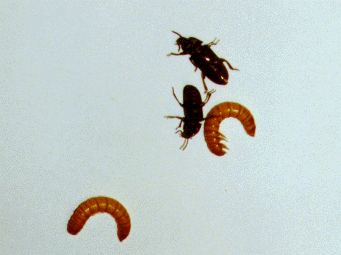About this Daily Classroom Special
Critter Corner allows teachers and students to learn and share experiences about organisms that can be kept in the classroom. Critter Corner is
maintained by Judith Jones, teacher at East Chapel Hill High School (NC) and
Teachers Network web mentor. E-mail Judith. Make sure to visit Judy's other Daily Classroom Special, The
Time Travel Interviews with Famous Scientists.
To the Critter Corner Directory.
Meal Worms/Darkling Beetle
Meal Worm Activity
 I first was introduced to meal worms when I bought
them to feed a lizard many decades ago. I confess that it never occurred to me that they were a larva of a beetle. I just bought them at a bait shop and fed them to my hungry "alligator lizard." After
deciding that trips to the bait shop were becoming too frequent, I decided to raise my own meal worms. It was then that I became acquainted with their life cycle. Now I use them
for reptile and amphibian food as well as wonderful observation lessons for my ninth grade biology students. I first was introduced to meal worms when I bought
them to feed a lizard many decades ago. I confess that it never occurred to me that they were a larva of a beetle. I just bought them at a bait shop and fed them to my hungry "alligator lizard." After
deciding that trips to the bait shop were becoming too frequent, I decided to raise my own meal worms. It was then that I became acquainted with their life cycle. Now I use them
for reptile and amphibian food as well as wonderful observation lessons for my ninth grade biology students.
Scientific Name: Tenebrio molitor
General Physical Description: The darkling beetle gets to be about 15-20 millimeters long. The antennae are like thin beaded threads
(great to look at with a magnifying glass!). They are dull black or brown and sometimes have a little red. Their eyes are notched. The larvae (meal worm) is about
30-35 millimeters long when full sized (although other varieties may be larger). It is golden colored and segmented (13-15 segments). There are little "foot-like" protuberances
on the ventral side attached to three anterior segments (future beetle legs).
Behavior: The larvae tend to cluster on the crumpled and moistened paper towels that I put into their aquarium. The beetles can be found
foraging all throughout the bran.
Reproduction: Beetles undergo complete metamorphosis - egg, larva, pupa, and adult. Tenebrio beetles lay their eggs in the grain;
the eggs hatch into tiny larvae (meal worms) that eat merrily away and grow rapidly. Eventually, they will change into a pupa out of which the adult beetle will emerge.
The larvae go through a series of stages called "instars." Each instar is preceded by a molting of the old skin. The female beetle emits pheromones that attact the
males. A male and female beetle mate and the male deposits sperm inside the female.
Classroom Habitat: I set up a large plastic aquarium filled with bran (about 6 inches in depth). I put a container of meal worms from
the bait shop into the aquarium. I keep moisture on top of the bran by slicing apples or potatoes and/or moistening crumpled up paper towels. Then I just sit back
and wait. Within a few weeks, I have beetles! One of my beginning activities involves students observing the beetles and larvae and trying to draw them in as much detail
as possible. My ninth grade students are always quite surprised to discover that there is a relationship between the golden "worms" and the dark black beetles!
Native Habitat and Role in the Environment: There are many genera of darkling beetles. They live under bark, in and around rotten wood,
on the ground or in termite and ant nests. They are scavengers; they feed on organic matter that is decaying. Tenebrio molitor lives in grain and is considered a pest
by farmers. As with many other creatures, they may be considered negative for humans when in fact they are vital to the global environment. The darkling beetles and
their larvae are first class recyclers of organic material. In Mexico, certain beetle larvae are served with rice and others are in bottle of the Mexican liquor, mescal.
In the United States, our fascination with the mescal larvae has resulted in a tequila-flavored lollipop that has the Tenebrio larva trapped inside.
Food and Feeding Schedule: The beetle/larva culture does very well with occasional additions of bran, apple slices, potato slices, and moisture.
I only tend to them a few times each month!
Handling Tips: The beetles and larvae can be picked up quite safely. If you put them into small dishes the students can examine them
with magnifiers and use their fingers to change positions of the insects.
A Critter Corner fan asks...
Hello, Ms. Jones!
My name is Wendy Donnan, I work at TVOntario in Toronto, Ontario Canada, as a Visual Researcher. We are a public, educational broadcaster, and I am currently involved in a search for video material
to use within courses we do with Canadian schools. I came across your website on mealworms, and we are currently searching for some video footage of the four stages of the mealworm. Would you have
any video footage? Or know where I could get my hands on some fairly quickly? (By next week) I would appreciate any help you can offer. The website was fantastic!
Thanks Wendy Donnan
TV Ontario
Dear Wendy,
I do not know of nor do I have any video footage of the life cycle of the mealworm. However, I know of a biological supply company in Burlington, NC that may be able to help you. If you need the
phone number, please call me at school.
Judy Jones
|